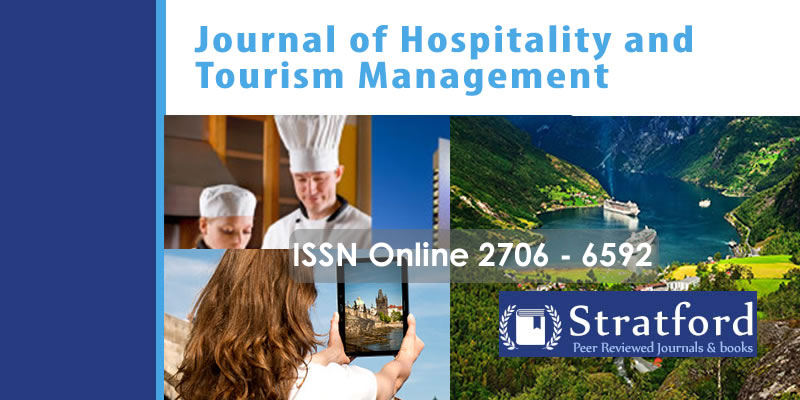Role of International Celebrity Events Destination Promotion on Tour Firms Performance in Nairobi City County, Kenya
Abstract
possess important social, cultural, and economic outputs. International celebrity events provide additional destination attraction and they create a sustainable tourism industry across many parts of the world. Despite research in recent times in events gaining tremendous interest among scholars and emerging as a crucial area of study, little is known on how international celebrity events hosting influences tour firms’ performance. This study explored the role of international celebrity events destination promotion on tour firms’ performance in Nairobi City County, Kenya. A cross-sectional research design was adopted for the study. The sample size of the study constituted of 390 managerial employees who were drawn from all the 329 tour firms registered with the Kenya Association of Tour Operators. Stratified, systematic, purposive, and convenient sampling approaches were used to sample the respondents, while questionnaires and interview schedules were used for collection of data. Results showed that the international celebrity events destination promotion depicted a positive and statistically significant relationship with tour firms performance (p=0.000<0.05). The study recommends development and hosting of special international celebrity events in the country by event organizers as the basis of increasing the competitiveness of Nairobi City County as a preferred tourist destination.
Keywords: International Celebrity Events Destination Promotion, Image, Hosting, Tour Firms, Performance, Competitiveness
References
Candrea, A. N., & Ispas, A. (2013). Promoting tourist destinations through sport events. The case of Braşov. Revista de turism-studii si cercetari in turism, (10), 61-67.
Cooper, D. R., Schindler, P. S., & Sun, J. (2006). Business research methods (Vol. 9). New York, NY: McGraw-Hill Irwin.
Fredline, L., & Jin, X. (2017). The Attractiveness of Australian Events to Chinese Visitors and Barriers to Attendance. Event Management, 21(6), 697–711.
Getz, D., & Page, S. J. (2016). Progress and prospects for event tourism research. Tourism Management, 52, 593-631.
Government of Kenya (GOK) (2017). National Tourism Blueprint 2030. Nairobi: Ministry of Tourism and Wildlife.
Greenfield, T., & Greener, S. (Eds.). (2016). Research methods for postgraduates.
Guccio, C., Lisi, D., Martorana, M., & Mignosa, A. (2017). On the role of cultural participation in tourism destination performance: An assessment using robust conditional efficiency approach. Journal of Cultural Economics, 41(2), 129-154.
Gupta, A. (2011). Terrorism and its impact on financial performance: A case of tourism industry. International Journal of Financial Management, 1(4), 46-52.
Hanafiah, M. H., Hemdi, M. A., & Ahmad, I. (2016). Does tourism destination competitiveness lead to performance? A case of ASEAN region. Tourism (13327461), 64(3), 251–260.
Heere, B., Wear, H., Jones, A., Breitbarth, T., Xing, X., Salcines, J. L. P., ... & Derom, I. (2019). Inducing destination images among international audiences: The differing effects of promoting sport events on the destination image of a city around the world. Journal of Sport Management, 33(6), 506-517.
Hemmonsbey, J. D., & Tichaawa, T. M. (2019). Using non-mega events for destination branding: A stakeholder perspective. GeoJournal of Tourism and Geosites.
Houdement, J., Santos, J. A. C., & Serra, F. (2017). Factors affecting the decision-making process when choosing an event destination: A comparative approach between Vilamoura (Portugal) and Marbella (Spain). Journal of Spatial and Organizational Dynamics, 5(2), 127-145.
Karl, M., & Schmude, J. (2017). Understanding the role of risk (perception) in destination choice: A literature review and synthesis. Tourism (13327461), 65(2), 138–155.
Kenya National Bureau of Statistics (2018). Economic Survey 2018. Retrieved from https://www.knbs.or.ke/download/economic-survey-2018/.
Kim, J., Kang, J. H., & Kim, Y. K. (2014). Impact of Mega Sport Events on Destination Image and Country Image. Sport Marketing Quarterly, 23(3), 161–175.
Komurcu, G. B., Boz, M., & Tukelturk, Ş. A. (2014). Festivals as a type of event tourism: tenedos local flavours festival sample case.
Lee, S., & Yoo, M. (2015). Examining celebrity fandom levels and its impact on destination loyalty. Journal of Quality Assurance in Hospitality & Tourism, 16(4), 369–388. https://doi.org/10.1080/1528008X.2015.1063354.
Milohnic, I., Licul, I., & Andjelic, J. (2016). The Importance of Event Impacts in the Tourist Destination. Varazdin: Varazdin Development and Entrepreneurship Agency (VADEA), 373-382.
Musgrave, J., & Okech, R. N. (2011). Promoting sustainable festival events tourism: A case study of Lamu Kenya. Worldwide Hospitality and Tourism Themes, 3(3), 193-202.
Mxunyelwa, S., & Mangisa, Y. (2018). Sport events tourism as a catalyst for image makers for tourist destinations: A case study of Buffalo City Metropolitan Municipality in relation to the Legends Marathon Event. African Journal of Hospitality, Tourism and Leisure, 7 (5), 2223-814X.
OECD (2017). Major events as catalysts for tourism, OECD Tourism Papers, 2017/02, OECD Publishing, Paris. http://dx.doi.org/10.1787/a0e8a96f-en.
Oklobdžija, S. (2015). The role of events in tourism development. Bizinfo (Blace) Journal, 6(2), 83-97.
Petrovic, V., Lakicevic, M., & Durkalic, D. (2019). The role of a sports event in creating a tourist offer in Vrnjačka Banja. Megatrend Review, 16(1), 95–109.
Seraphin, H., & Gowreesunkar, V. G. (2017). Unlocking changes for sport tourism products in small islands: The case of Martinique. Journal of Hospitality & Tourism, 15(1), 60–81.
Waller, S., Trendafilova, S., & Daniell, R. (2014). Did the 2012 World Series positively impact the image of Detroit? Sport as a transformative agent in changing images of tourism destinations. Journal of Sport & Tourism, 19(1), 79–100.
Word Travel and Tourism Council (2018). Travel & Tourism Economic Impact 2017 Kenya.
Yilmaz, E., & Aslan, T. (2017). Evaluation of performance of tourism industry companies listed in Istanbul Stock Exchange (BIST) by TOPSIS Methodology. EMAJ: Emerging Markets Journal, 7(2), 8–18.


